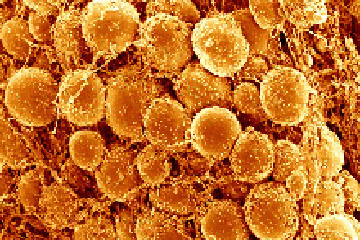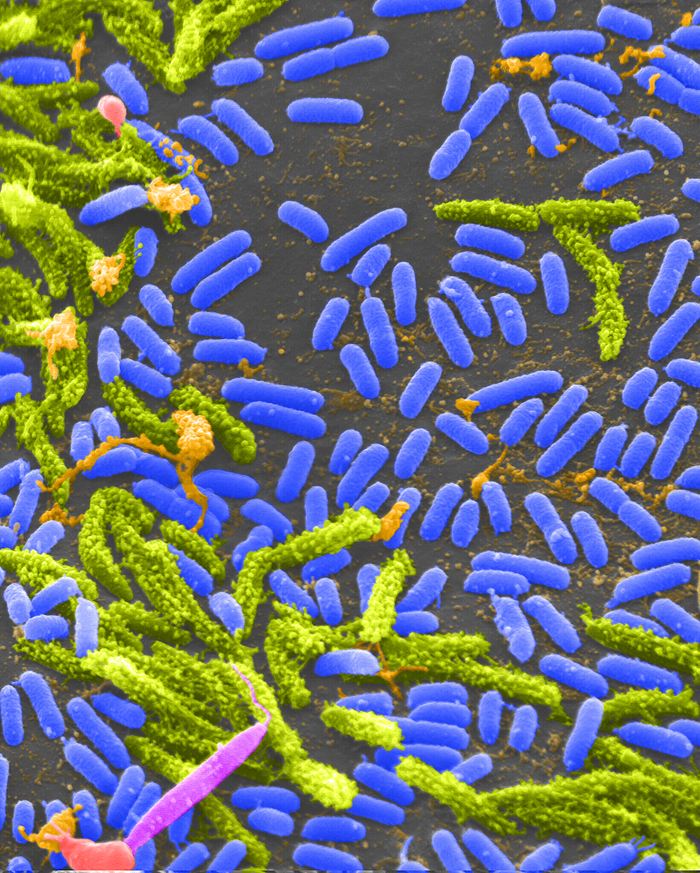Cells Are Chatty: Here's What They May Be Saying

Living things are chatty creatures. Even when they're not making actual sounds, organisms constantly communicate using chemical signals that course through their systems.
In multicellular organisms like people, brain cells might call, "I'm in trouble!" signaling others to help mount a protective response. Single-celled organisms like bacteria may broadcast, "We have to stick together to survive!" so they can coordinate certain activities that they can't carry out solo.
In addition to sending out signals, cells have to receive information. To help them do this, they use molecular "ears" called receptors on their surfaces. When a chemical messenger attaches to a receptor, it tells the cell what's going on and causes a response.
Scientists funded by the National Institutes of Health are following the dialogue, learning how cell signals affect health and disease. Researchers are also starting to take part in the cellular conversations, inserting their own comments with the goal of developing therapies that set a diseased system right.
Signalling a Long, Skinny Life
In cellular conversations, the "words" often take the form of small molecules, or chemicals, released by one cell and received by receptors on another. In multicellular animals, hormones are a common form of chemical message.
For instance, our liver cells release the hormone FGF21 to tell fat cells when it's time to burn off some fat for energy. This signal makes FGF21 of interest to scientists who want to treat obesity and type 2 diabetes.
Get the world’s most fascinating discoveries delivered straight to your inbox.
To investigate the role of the hormone, David Mangelsdorf and Steven Kliewer of the University of Texas Southwestern Medical Center engineered mice to produce extra FGF21. The dramatic result: smaller mice, though they had normal proportions of fat and lean mass. It turns out that the FGF21 signal interrupts other signals involved in growth. Another major change was that the mice lived for up to 4 years, compared to the typical 2.
But there were also negative effects. The mice with extra FGF21 had low bone density, as if they were getting osteoporosis. And the female mice couldn't have pups. Mangelsdorf and Kliewer are trying to figure out what other side effects the FGF21 signal might have in different parts of the body.
"Here's a compound that is a potential anti-obesity drug and might also make you live a long time … if the side effects could be overcome," Mangelsdorf says. Now, he and Kliewer are working to better understand exactly how FGF21 creates these positive and negative changes in the body.
Tamping Down Tumors
In the back and forth of cellular communication, endothelial cells are major players. These cells, which line blood vessel walls, are covered in receptors, processing information such as the rate of blood flow. They also send molecular signals that control blood clotting, immune responses and other processes.
In addition, endothelial cells communicate with cancer cells to curb their growth, says Elazer Edelman of the Massachusetts Institute of Technology and Harvard Medical School. But a tumor sends signals of its own, convincing the endothelial cells to send signals that aid cancer growth.
Edelman developed a treatment that might help: a package of healthy endothelial cells, implanted near a tumor, that acts as backup for the body's natural cancer-controlling endothelium. The implanted cells produce complex messages — Edelman has not yet defined all the elements — to keep the cancer in check.
In tests he's done using mice, the implants suppress cancer, but Edelman still has to work out which types of cancers respond best. His collaborators have also tested the implants in healthy people to make sure they're safe before trying them in cancer patients.
Silencing Bacteria
Bacteria communicate with each other using a process called quorum sensing. By sending and listening for "I'm here" signals, they can figure out if they're alone or in a community. Once a number of cells are together — forming a "quorum" — they act differently than if they were alone. They might invade host cells or start to make toxins or biofilms.
If scientists could silence quorum signaling, they could potentially block bacterial damage to cells, reasons Vern Schramm at Albert Einstein College of Medicine of Yeshiva University. His lab works on chemicals that turn off the activity of enzymes, proteins that speed biological reactions.
Bacteria need the MTAN enzyme for quorum sensing. Schramm designed an inhibitor that jams MTAN, like a key stuck in a lock. "This cuts the telegraph wires between the bacteria so they can't communicate," he says.
Schramm's inhibitor has an advantage over antibiotics currently being prescribed. Those drugs kill bacteria, but the bacteria are able to evolve ways to evade the attack. This leads to antibiotic resistance, which is a serious problem because doctors are running out of drugs that work against some bacteria. But Schramm grew cholera bacteria with MTAN inhibitors for 26 generations, and they never evolved a way to escape the treatment. Schramm is currently looking to develop the inhibitors into what he calls "everlasting antibiotics."
Schramm never thought that would be his goal — he started out just trying to understand enzymes. He points out that this is a good example of how basic research on fundamental processes like cellular communication can lead the way to new medicines.
This Inside Life Science article was provided to Live Science in cooperation with the National Institute of General Medical Sciences, part of the National Institutes of Health.
Learn more:
Bugging the Bugs from Findings Magazine
Also in this series:



